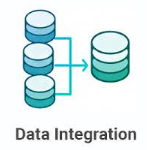Enterprise Performance Management (EPM) software offers a wide variety of tools to help businesses plan, budget, forecast and analyze their performance very effectively. This is done by integrating data from various sources with the EPM software in order to provide valuable insights into historical data which enable organizations to make informed decisions about future operations not just that by integrating planning we can forecast better.
Data Integration and Analysis

EPM software can integrate data from various sources, including:
- ERP information’s: Data on financial transactions, customer relationships, and supply chain operations are gone
- Point of Contact: Data on customer interactions, sales trends, and market demand.
- HRMS: Data on employee performance, compensation, and training.
- WHMS: Data on inventory levels, production schedules, and logistics.
By combining data from these and other sources, EPM software provides a overview of business performance. This data can be used to:
- Analyze past performance: key metrics may help you Identify trends, identify areas for improvement and understand the root causes of performance issues.
- Measure key performance indicators (KPIs): KPI help in tracking progress towards goals and identify areas where performance is lagging.
- Generate reports and dashboards: Visualize data and communicate key findings to stakeholders.
Planning and Forecasting
A good EPM software provides tools for planning and forecasting future performance. These tools can be used to:
- Create realistic and achievable financial plans using various designs for forecasting and capturing budgets
- Manage business with simulation modeling helping to evaluate the potential impact of different business decisions and market conditions.
- Optimize resource allocation can become crucial and EPM help to maximize return on investment.
- With EPM software, proactively identify and address potential challenges that will keep the company in the curve of progress.
Integration with Planning
EPM software can be integrated with various tools like:
- Align financial plans with strategic objectives by connecting with the ERP that host all the data for accounting.
- Ensure that projects are on track and within budget with project management tools that enable end to end solution of projects.
- Optimize inventory levels and production schedules with connecting to WHMS and get more realistic data real-time to see and navigate complexities in inventory management.
- There are various other integrations that may be done to give the company a holistic approach of tracking KPI and maintaining a positive growth.
Thes integrations allows businesses to develop a comprehensive and integrated plan that addresses all aspects of their operations.
Simulations
Simulations are a powerful tool that can be used to evaluate the potential impact of different decisions and scenarios. EPM software can be used to:
- Conduct “what-if” analyses to evaluate the potential impact of different assumptions and variables that might give varied outcome.
- A good simulations system to be able to test different strategies determine the most effective course of action for achieving business goals.
- Assess the potential impact of unforeseen events and then try to mitigate the risks and more focus on control measures.
Simulations in an EPM software can help businesses make more informed decisions and reduce the risk of costly mistakes.
Benefits of EPM Software
The benefits of using EPM software include:
- Access to accurate and timely data enables businesses to make more informed decisions and stay ahead of competition for business.
- With EPM tools automation of tasks, such as planning, budgeting and forecasting, frees up time for more strategic activities.
- A good EPM software provides a central platform for helps in collaboration among different departments and stakeholders to address a single goal across the entire organisation.
- By identifying areas for improvements and tracking progress towards goals, EPM software can help businesses improve their overall performance.
- By identifying risk, we can easily address and mitigating risks, EPM software enables and help businesses protect their bottom line by proactively uncovering the risk through simulation modeling.
In general EPM software is a very valuable tool for any business that wants to progress and improve its performance in various areas of work. By integrating data from various sources providing tools for budgeting, planning and forecasting, enabling the use of simulations to identify and mitigate risks, the EPM software can help businesses make more informed decisions, improve efficiency and achieve their strategic objectives.

